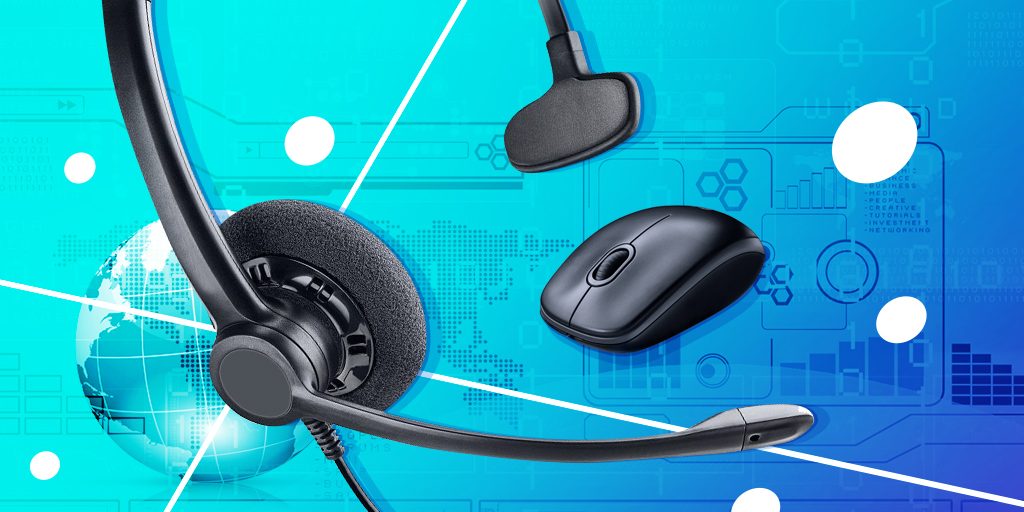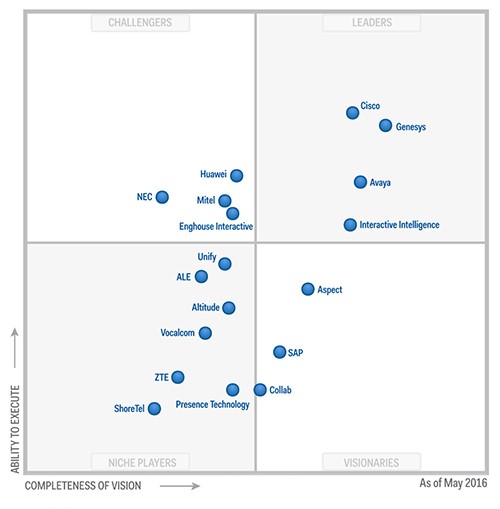
By: Scott Stavretis
For contact centres around the world, the choice is clear. Recent events have shaken the infrastructure provider space to clearly bring one provider to the head of the pack. But first, let me give you some background.
The Gartner Magic Quadrant provides a bird’s-eye view of the positioning of competitors in a market. This is published by the American research and advisory firm, Gartner Inc. (NYSE: IT). Gartner is the world’s leading information technology research and advisory company that provides qualitative analysis into a market and its direction, maturity and participants.
Gartner published a Magic Quadrant for Contact Centre Infrastructure, Worldwide, with the last quadrant released in May 2016. Since that release, a lot has changed. Let’s look at what that quadrant means first.
The quadrant is broken up into four squares (or quads) that illustrate the strength and differences between competitors.
➤Niche Players – These players score low in both completeness and vision and the ability to execute. Whilst they may do very well in a part of the market, they may not be able to compete with some of the larger vendors across the market.
➤Visionaries – These are players that have a vision and may be able to innovate. However, there tends to be doubt about their ability to meet the vision (and they are not there yet!). Often, these are early stage players or larger players that are pivoting their position in the market.
➤Challengers – These players are out there executing and delivering today. However, they may not seem to be executing on an improved vision and seem stagnant.
➤Leaders – The leaders score high on both completeness of vision and ability to execute. Typically, Leaders (especially in this case) are highly visible, credible and mature players in the market.
I don’t recommend just looking at the Leaders. There are many reasons why you may not choose to do so. But in the contact centre industry, it’s often the only option for businesses.

Gartner is due to release another quadrant for Contact Centre Infrastructure, Worldwide in February. Let’s take a look at the leaders from the last quadrant in May 2016, add some of these developments as well as their past history for a fresh perspective.
➤ Cisco
Cisco is a big, global beast. They rate the highest in ability to execute but fall behind in vision. They’ve made a name for themselves innovating highly reliable networking infrastructure—they’ve been a major force in how many technologies interact today. But to me, they don’t have a clear roadmap (or vision) for their Unified Contact Centre enterprise solution and haven’t been able to put the proper resources behind it, as well. Back in the day, it was an absolutely great platform that was highly reliable. However, the feature set just doesn’t seem to be there. And I wouldn’t hold my breath that it’s coming anytime soon.
They often seem to be playing catch-up and attempt to acquire other vendors for each piece that they want to bolt on to their platform. This tends to cause significant inter-operability problems and can become a real piecemeal solution—leading to support issues, slowness to progress the roadmap and staying ahead of the innovation curve (compared to simply acquiring it post-fact). Unless Cisco really commits to contact centre infrastructure, I don’t see any good reason why organisations would implement this nowadays as we move beyond a world of Unified Communications (which they’re far from mastering) into the unknown. The only certainty is that change will happen and will happen quickly. Possibly the only reason people would take this option is for the saying ‘No one has ever been fired for buying Cisco.’ Oh wait, that was IBM!
For their lack of innovation and clearly focused roadmap—they’re out!
➤ Interactive Intelligence
Almost the opposite of everything I said about Cisco applies. Whilst founded only 10 years after Cisco (in 1994), ININ is a relatively newcomer to the major player scene. When I met with the founder, Dr. Donald Brown, I was very impressed with his vision of the platform. Their product set was impressive and development of rich features seemed to be of extreme priority. Whilst they too have had acquisitions along the way, the system appears to be one integrated platform, one solution. For a lightweight platform, it was impressive. But there remain real doubts on its scalability to a larger customer base.
On 1 December 2016, Genesys (see below) completed the acquisition of ININ. This was a remarkable move (in my opinion) to leverage the innovations that ININ was so known for. Genesys has indicated (subtly) that ININ is a good out-of-the box product for entry level and smaller players. The Genesys platform remains the real solution for industry leaders with ININ bringing an advanced cloud-on-omni-channel solution, as well as key technical R&D and support talent. This is a smart play by Genesys—although I’m not sure where the real integration of the ININ product will come in. It will be interesting to see the roadmap they have promised to release in ‘early 2017’. Without this and without real commitment from Genesys on ININ, it doesn’t seem to be a savvy investment for a long-term contact centre solution.
Not knowing what Genesys’ real plans are for ININ (except to possibly keep it for small customers)—they’re out!
➤ Avaya
They’re the well-established behemoth of telephony and customer contact technology. Their range is broad—from handsets, to applications, to wireless technology networking, telephony and contact centre platforms. To me, they’ve been quite bogged down due to contact centre telephony not being their sole focus (unlike the focus Genesys has). However, their product has consistently delivered. And whilst we hear about implementation nightmares, it’s certainly a trusted and proven technology in thousands of global corporations. As recent as last year, they were looking at selling off their contact centre business and evaluated expressions of interest that never materialized. Clearly this sends a non-core message.
Then there arose a big problem with the Avaya US (parent) entity in January this year—they filed for chapter 11 bankruptcy with $6.3B of debt that they want to restructure. Whilst they’ve managed to secure $725M in funding underwritten by Citibank to keep operating during this process, the future is unclear. Of course, the talk is of restructuring the balance sheet, trading as normal and continuing (even possibly stronger) as normal. This may not be possible.
Whilst many companies can come out of Chapter 11 and be stronger than ever (think American Airlines), many don’t come back. Or if they come back, it’s a much different version of themselves. And remember, this is a company with a history of significant long-term debt, financial losses and a decline in revenue! Will there be a white knight? Can they restructure as planned? I’m not betting an entire contact centre platform and its future vision on that and I don’t think any organisation should.
They are in Chapter 11 bankruptcy with long-term debt that has constantly crippled them. And they have no clear options on how to recover—they’re out!
➤ Genesys
They’re a provider highly focused on customer experience and call centre technology for mid-sized and large businesses. And they’re growing! They’re clear on what they are and what they’re not; they’ve focused on contract centre technology and delivered. Gartner recognises them as Leaders and that was before they acquired ININ! They’ve traditionally been very strong in, what I would consider, the two most challenging and larger verticals, financial services and technology. They’ve got their product right across the breadth of these two verticals and then broadened their product from there into cloud and full Unified Comms. After talking to their President, Tom Eggemeier, and hearing about their laser-focused attitude to business and servicing the contact centre industry, I’ve developed much greater respect.
Everything Genesys is doing points to innovation, stability and growth. In my opinion, they are now the only choice and they will own this call centre infrastructure space for some time to come. They remain in and are really the only option!
At Acquire BPO , we couldn’t have foreseen these changes last year (i.e. the acquisition of ININ and the bankruptcy of Avaya). However, the industry knowledge of our team has certainly guided us to the right direction when we made the decision replace our outdated Cisco platform to the latest Genesys platform in 2015. We are Genesys’ first BPO partner and we absolutely enjoy the satisfaction our clients experience on the Genesys platform, given its rich feature set, and we’re proud to continue seeing Genesys on Gartner’s Leader’s quadrant!













